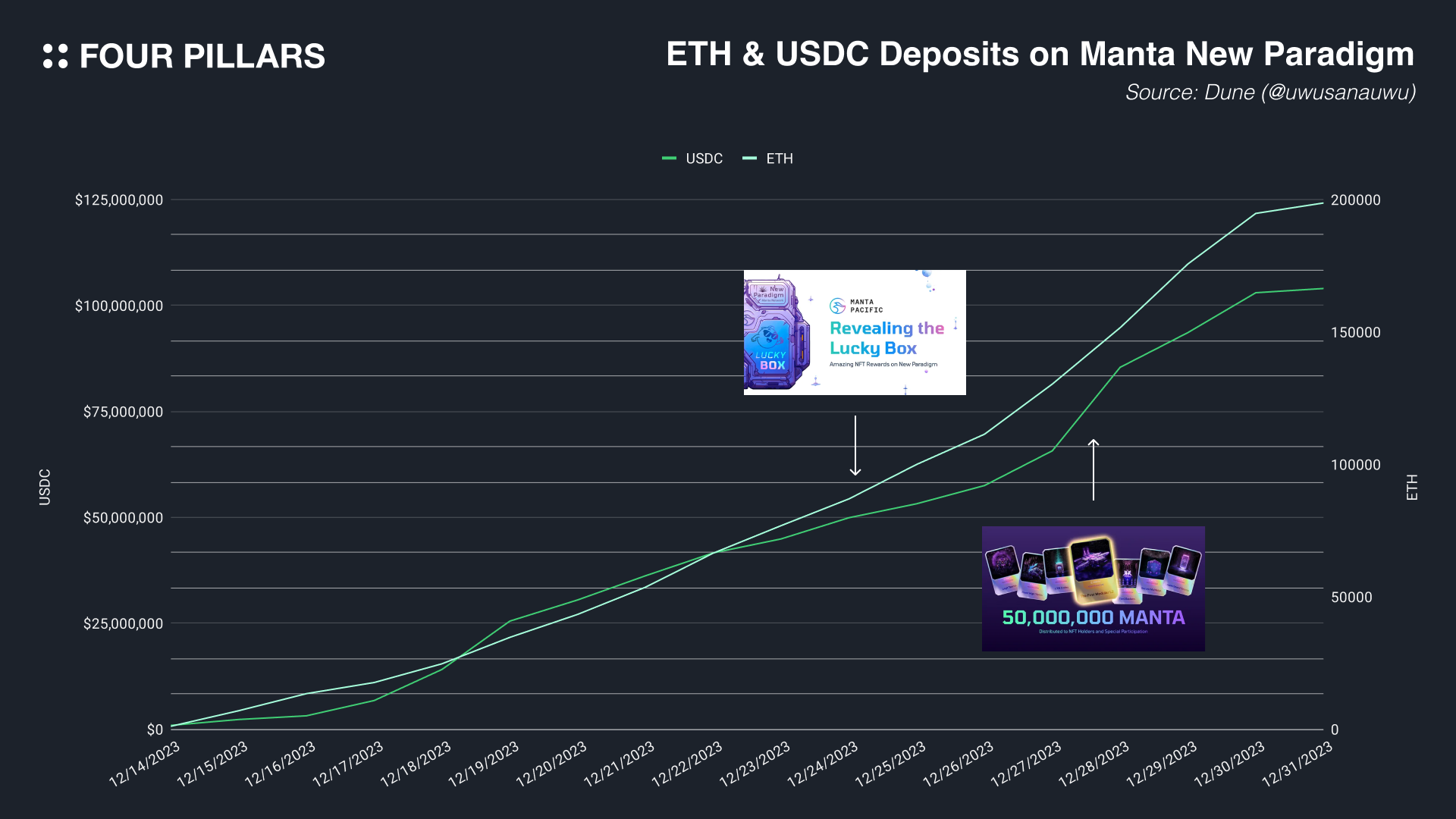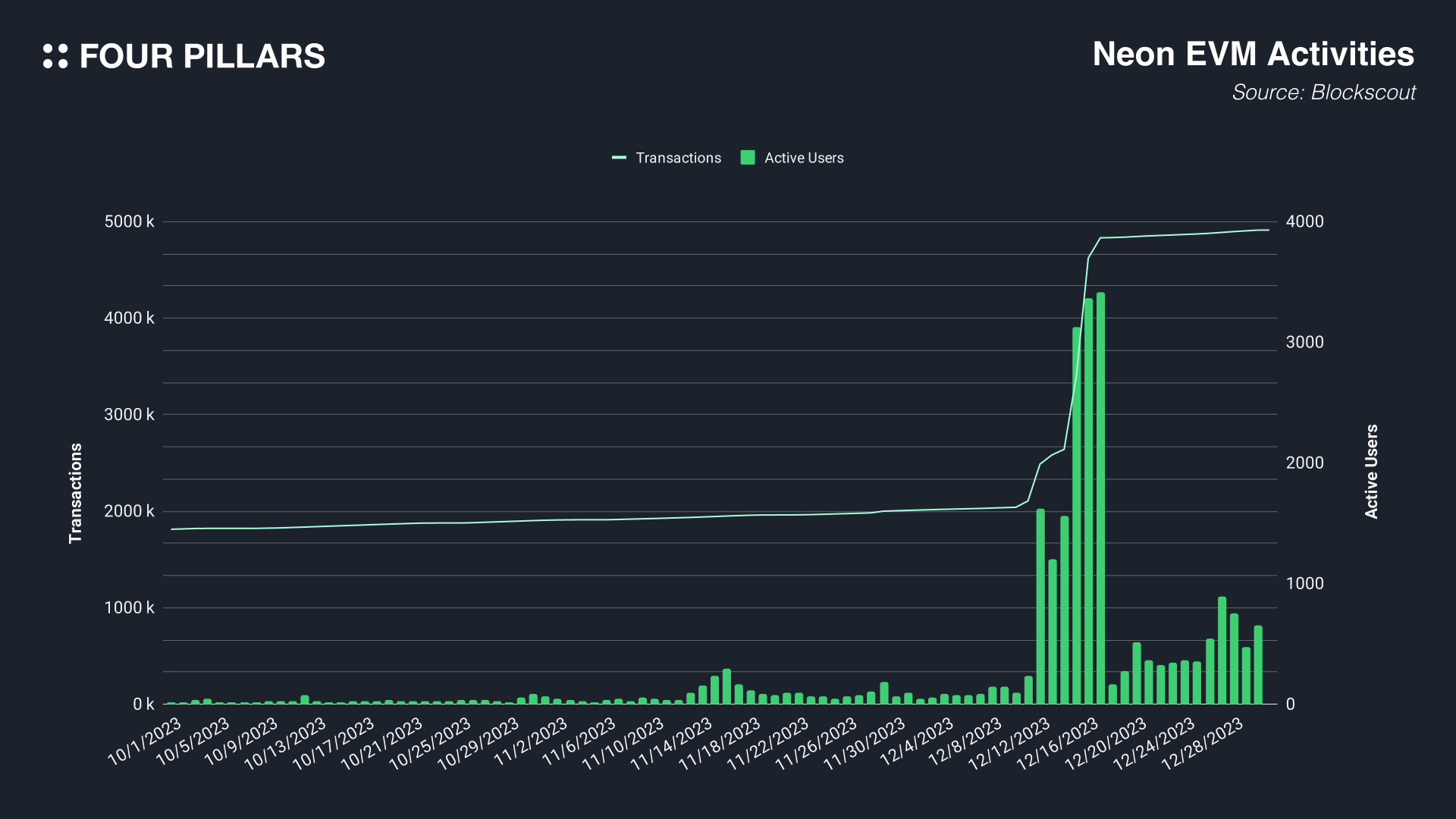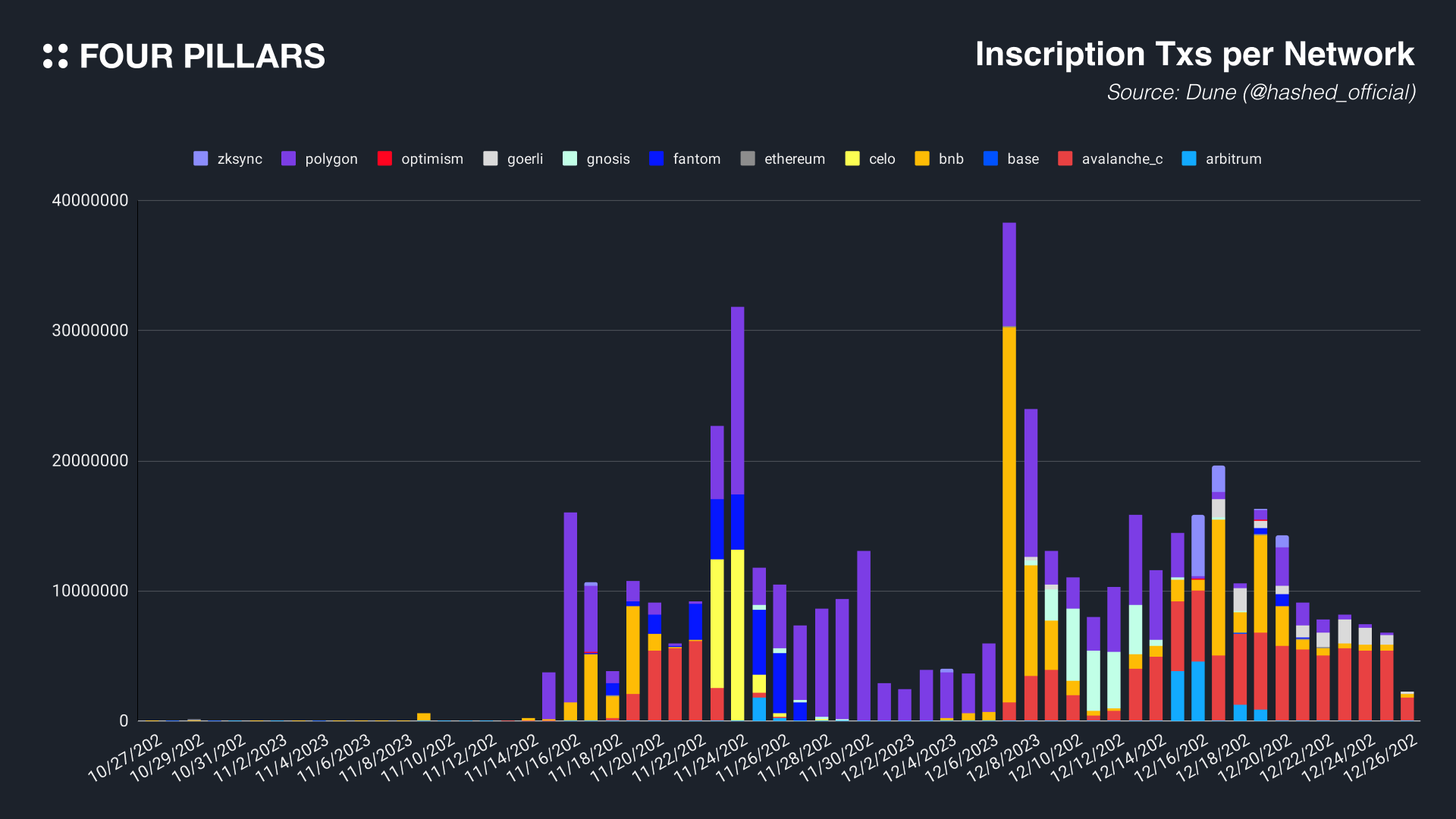


Manta is a blockchain specialized for Zero-Knowledge (ZK) applications, consisting of two separate networks: the Manta Atlantic network, based on Polkadot's Substrate SDK, and the Manta Pacific network, built on Polygon's CDK. The Manta Pacific network, functioning as a modular zkEVM L2 network, uses Ethereum for settlement and Celestia for data availability. This network has recently initiated an ecosystem bootstrapping event called New Paradigm, similar to the strategy of Blast L2, starting from December 14th. By December 31st, it onboarded assets worth an impressive $565M from the Ethereum network.
Users participating in the New Paradigm event can deposit ETH and USDC from the Ethereum mainnet into a bridge contract and receive them as STONE and wUSDM on the Manta Pacific network. STONE represents ETH earning liquid re-staking interest through the StakeStone protocol, while wUSDM is a stablecoin earning interest backed by U.S. bonds through the Mountain Protocol. Additionally, users can receive six different types of NFTs of varying rarities through Lucky Box items proportional to their deposits, which can be exchanged for MANTA tokens in January.
Unlike Blast, Manta Pacific already had an existing mainnet, which enabled it to avoid criticism related to bridge contracts. It offered additional interest-earning avenues such as re-staking via EigenLayer and DeFi farming within Manta Pacific, leading to a significant onboarding of users and funds despite being a second attempt following Blast. The secondary trading of earned NFTs allowed users to monetize their rewards early, maintaining and even increasing the pace of ETH and USDC deposits after the release of announcements on Lucky Boxes and NFT rewards.
Manta Pacific, ranking 6th in TVL among L2 networks as seen on L2Beat, has successfully garnered significant attention. However, the community has raised concerns regarding Manta Pacific's technical and security aspects. These include unresolved issues with StakeStone's unproven smart contracts and challenges with Blobstream's functionality in verifying data stored on Celestia within the Ethereum network.

EigenLayer is a protocol designed for ETH restaking, allowing the reuse of staked ETH for securing other PoS protocols. This setup places ETH restakers under two slashing conditions. However, it offers the advantage of earning rewards from both Ethereum block rewards and other PoS protocols, potentially leading to higher returns.
Since its launch, EigenLayer has implemented a cap on the total amount of ETH that can be restaked. On December 18th, they expanded the variety of Liquid Staking Tokens (LST) eligible for restaking (previously limited to stETH, rETH, and cbETH) and increased the restaking limit from 120,000 ETH to 500,000 ETH. Consequently, the total value of LST deposited in EigenLayer surpassed $1 billion. Additionally, there has been a recent surge in the number of EigenPods, with Ethereum validators staking the required 32 ETH, reaching approximately 4,200 in number.
Furthermore, the Liquid Restaking Protocol has emerged within EigenLayer. This protocol further liquidates ETH restaked in EigenLayer, enabling investors to earn from three sources: 1) ETH rewards, 2) PoS protocol rewards, and 3) DeFi yields. Protocols like KelpDAO, Swell, and EtherFi are gaining significant attention in the realm of liquid re-staking.

December brought a positive turn in the market, giving rise to a variety of investment narratives. Among these, the narrative around Parallel EVM stood out. The EVM is inherently designed to process transactions sequentially, but Parallel EVM introduces technology that enables parallel transaction processing while using the EVM. Notable projects in the Parallel EVM space include Sei, Monad, Neon, and Polygon PoS. These networks implement Parallel EVM using technologies like STM and Sealevel. The increased attention to Parallel EVM narratives resulted in a significant rise in related token prices and network activity. Neon EVM, which had not garnered much interest before, saw a sharp increase in active users and transaction numbers in December. Sei experienced a dramatic rise in weekly active users from 5.7k on December 4th to 36.3k the following week, marking a 736% increase. The launch of Monad is also anticipated in 2024, making it interesting to see if the Parallel EVM narrative continues into the new year.
(See more: ‘Why Sei Network’s V2 Upgrade is Particularly Interesting?’ by Steve)

In December, there was significant inscription activity across various networks following November. On December 15th, Arbitrum's sequencer halted for 1.5 hours due to an overload of inscription transactions. Avalanche saw transaction fees skyrocket to over $1,500, indicating that inscriptions caused congestion in many networks. Polygon PoS, which had the highest number of inscriptions, managed to operate smoothly without major disruptions, thanks to the implementation of Parallel EVM. For more detailed information on the inscription activities in November and December, refer to the following research article.
(See more: ‘Inscriptions Everywhere’ by 100y)
Vitalik proposes sticking to 8192 signatures per slot post-SSF
Starkware builds a data availability interface to integrate Avail’s DA layer for Madara
Cronos Labs Launches Public zkEVM Testnet Using zkSync's ZK Stack Technology
LINE NEXT (developer of Finschia) Raises USD140 Million to Expand Web3 Ecosystem
Sei introduces Sei v2 - The First Parallelized EVM Blockchain
Launching the PBS Foundation: Working Together to Keep Ethereum’s Consensus Layer Decentralized
Ethereum staking network SSV launches permissionless mainnet
Mantle offers ‘mETH’ to the masses, as a ‘lighter weight Lido’
Ledger’s web 3 connector has been compromised, endangering various DeFi protocols
Sotheby’s New York presents an online sale featuring select BitcoinShrooms from the bitcoin ordinals
BlackRock, Valkyrie Name Authorized Participants Including JPMorgan for Bitcoin ETF
Hong Kong Regulators Propose Mandatory Licenses for Fiat-Backed Stablecoin Issuers
In January 2024, one of the most anticipated events is the potential approval of a Bitcoin spot ETF. If approved, it would mark one of the most significant events in the 16-year history of blockchain, dramatically improving accessibility to Bitcoin spot markets. The final decision dates for the ETF applications by Ark Invest and 21 Shares are scheduled for January 10, 2024. Considering the SEC's track record of simultaneous approvals for all asset managers' ETFs, as observed with past Bitcoin and Ethereum futures ETFs, it's anticipated that a multitude of Bitcoin spot ETFs could receive approval before January 10th. On December 30th, BlackRock registered JP Morgan and Jane Street as ETF Authorized Participants (AP), leading analysts like James Seyffart and Eric Balchunas of Bloomberg to express opinions that the probability of a Bitcoin spot ETF approval is over 90%. However, Cathie Wood of Ark Invest has suggested that the approval might not immediately lead to a rise in BTC prices and could potentially trigger a 'Sell on news' effect.
Sota Watanabe, founder of Astar, tweeted that dApp staking v3 and token economics 2.0 are internally ready and planned to launch in early 2024. dApp staking is a key feature of Astar, aimed at encouraging a vibrant developer ecosystem by allowing dApps to earn network rewards. The dApp staking v3 aims to address issues in the existing system, like dApp registration and reward processes, through a redesign of the dApp staking pallet (module). Token Economics 2.0 seeks to address high inflation and the extensive allocation of tokens to the treasury and collators in the existing system. It will introduce dynamic inflation based on TVL and increase token burns per transaction, aiming to reduce overall network token inflation to around 5.8%. While v3 and 2.0 updates don't completely overhaul the system, they are expected to impact ASTR token performance positively.
EIP-4844 is an upgrade introducing a new storage space called 'blob' to the Ethereum network, allowing rollup networks to store more transaction data cost-effectively. This upgrade is set to be included in the upcoming Dencun hard fork. According to the Ethereum Github, the Dencun hard fork is scheduled for January 17, 2024, on the Goerli testnet, followed by the Sepolia testnet on January 30 and the Holesky testnet on February 7. The successful implementation of EIP-4844 in testnets will be crucial to watch, as it could significantly catalyze the Ethereum and rollup ecosystems. Observers should closely monitor 1) how the ecosystem expands in response to reduced rollup fees on the Ethereum network and 2) changes in transaction fees and profitability across various rollup networks.
With the improving market conditions, various ecosystems have started operating their ecosystem funds again. Examples include the Metis Foundation’s $100M fund, the Mina Foundation’s grant program Core, the Wemix Foundation and Whampoa Digital’s $100M fund, and Finschia’s eco-fund. Similar trends were observed in 2021 when many ecosystems launched their funds in the bull market. While these funds might have short-term effects, they proved detrimental in the long term for ecosystems that failed to find Product-Market Fit (PMF). It remains to be seen if the mainnets announcing ecosystem funds this time have learned from past lessons and will manage to operate them successfully.
Thanks to Kate for designing the graphics for this article.
We produce in-depth blockchain research articles

The crypto industry, initiated by Bitcoin, has developed through the narrative game and is now entering a stage where its technical infrastructure is maturing. Crypto provides a foundation to assign economic value to any idea or interest and enables trading, paving the way for new types of applications and business models. Currently, the crypto industry faces the key challenge of developing popular applications and attracting users. To achieve this, it is necessary to actively apply strategies that leverage speculative demand as a core function.

This article is the last part of a three-part series covering the DeFerence 2024 event, sponsored by Four Pillars.

Base, aiming to onboard 1B onchain users, has emerged as a hub for consumer-oriented onchain applications within a year since its mainnet launch last year, driven by factors such as reduced fees, the memecoin frenzt, and the growth of social network applications like Farcaster. Unlike other blockchain ecosystems focused on DeFi and infrastructure, Base predominantly features consumer-oriented applications similar to Web2 services. It leverages a unique community and brand to onboard more applications. While social and community applications are the most actively developed, new categories of onchain applications in content, gaming, and commerce are also emerging, indicating significant potential for user expansion.

This article is the second part of a three-part series covering the DeFerence 2024 event, sponsored by Four Pillars.